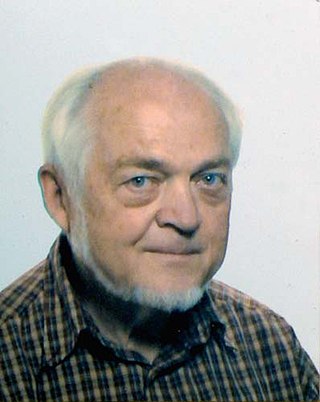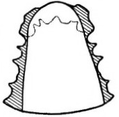Approximants are speech sounds that involve the articulators approaching each other but not narrowly enough nor with enough articulatory precision to create turbulent airflow. Therefore, approximants fall between fricatives, which do produce a turbulent airstream, and vowels, which produce no turbulence. This class is composed of sounds like and semivowels like and, as well as lateral approximants like.

In articulatory phonetics, the manner of articulation is the configuration and interaction of the articulators when making a speech sound. One parameter of manner is stricture, that is, how closely the speech organs approach one another. Others include those involved in the r-like sounds, and the sibilancy of fricatives.
A vowel is a syllabic speech sound pronounced without any stricture in the vocal tract. Vowels are one of the two principal classes of speech sounds, the other being the consonant. Vowels vary in quality, in loudness and also in quantity (length). They are usually voiced and are closely involved in prosodic variation such as tone, intonation and stress.
Sibilants are fricative consonants of higher amplitude and pitch, made by directing a stream of air with the tongue towards the teeth. Examples of sibilants are the consonants at the beginning of the English words sip, zip, ship, and genre. The symbols in the International Phonetic Alphabet used to denote the sibilant sounds in these words are, respectively,. Sibilants have a characteristically intense sound, which accounts for their paralinguistic use in getting one's attention.
The voiced alveolar fricatives are consonantal sounds. The symbol in the International Phonetic Alphabet that represents these sounds depends on whether a sibilant or non-sibilant fricative is being described.

The voiced dental fricative is a consonant sound used in some spoken languages. It is familiar to English-speakers as the th sound in father. Its symbol in the International Phonetic Alphabet is eth, or and was taken from the Old English and Icelandic letter eth, which could stand for either a voiced or unvoiced (inter)dental non-sibilant fricative. Such fricatives are often called "interdental" because they are often produced with the tongue between the upper and lower teeth, and not just against the back of the upper teeth, as they are with other dental consonants.

The voiced palatal plosive or stop is a type of consonantal sound in some vocal languages. The symbol in the International Phonetic Alphabet that represents this sound is ⟨ɟ⟩, a barred dotless ⟨j⟩ that was initially created by turning the type for a lowercase letter ⟨f⟩. The equivalent X-SAMPA symbol is J\.

The voiceless alveolo-palatal sibilant fricative is a type of consonantal sound, used in some spoken languages. The symbol in the International Phonetic Alphabet that represents this sound is ⟨ɕ⟩. It is the sibilant equivalent of the voiceless palatal fricative, and as such it can be transcribed in IPA with ⟨ç˖⟩.
The voiceless dental non-sibilant fricative is a type of consonantal sound used in some spoken languages. It is familiar to English speakers as the 'th' in think. Though rather rare as a phoneme among the world's languages, it is encountered in some of the most widespread and influential ones. The symbol in the International Phonetic Alphabet that represents this sound is ⟨θ⟩, and the equivalent X-SAMPA symbol is T. The IPA symbol is the Greek letter theta, which is used for this sound in post-classical Greek, and the sound is thus often referred to as "theta".

The voiceless retroflex sibilant fricative is a type of consonantal sound used in some spoken languages. The symbol in the International Phonetic Alphabet that represents this sound is ⟨ʂ⟩ which is a Latin letter s combined with a retroflex hook. Like all the retroflex consonants, the IPA letter is formed by adding a rightward-pointing hook to the bottom of ⟨s⟩. A distinction can be made between laminal, apical, and sub-apical articulations. Only one language, Toda, appears to have more than one voiceless retroflex sibilant, and it distinguishes subapical palatal from apical postalveolar retroflex sibilants; that is, both the tongue articulation and the place of contact on the roof of the mouth are different.

The open back rounded vowel, or low back rounded vowel, is a type of vowel sound, used in some spoken languages. The symbol in the International Phonetic Alphabet that represents this sound is ⟨ɒ⟩. It is called Latin turned alpha being a rotated version of Latin alpha. It seems a "turned script a", being a rotated version of "script (cursive) a", which is the variant of a that lacks the extra stroke on top of a "printed a". Latin turned alpha a⟨ɒ⟩ has its linear stroke on the left, whereas Latin alpha a⟨ɑ⟩ has its linear stroke on the right.
The close front rounded vowel, or high front rounded vowel, is a type of vowel sound, used in some spoken languages. The symbol in the International Phonetic Alphabet that represents this sound is ⟨y⟩, and the equivalent X-SAMPA symbol is y. Across many languages, it is most commonly represented orthographically as ⟨ü⟩ or ⟨y⟩ but also as ⟨u⟩ ; ⟨iu⟩/⟨yu⟩ ; ⟨уь⟩ ; or ⟨ү⟩.

The close central rounded vowel, or high central rounded vowel, is a type of vowel sound used in some spoken languages. The symbol in the International Phonetic Alphabet that represents this sound is ⟨ʉ⟩, and the equivalent X-SAMPA symbol is }. Both the symbol and the sound are commonly referred to as "barred u".

The close-mid front rounded vowel, or high-mid front rounded vowel, is a type of vowel sound used in some spoken languages.

The open-mid front rounded vowel, or low-mid front rounded vowel, is a type of vowel sound, used in some spoken languages. The symbol in the International Phonetic Alphabet that represents the sound is ⟨œ⟩. The symbol œ is a lowercase ligature of the letters o and e. The sound ⟨ɶ⟩, a small capital version of the ⟨Œ⟩ ligature, is used for a distinct vowel sound: the open front rounded vowel.
In phonetics, vowel roundedness is the amount of rounding in the lips during the articulation of a vowel. It is labialization of a vowel. When a rounded vowel is pronounced, the lips form a circular opening, and unrounded vowels are pronounced with the lips relaxed. In most languages, front vowels tend to be unrounded, and back vowels tend to be rounded. However, some languages, such as French, German and Icelandic, distinguish rounded and unrounded front vowels of the same height, and Vietnamese distinguishes rounded and unrounded back vowels of the same height. Alekano has only unrounded vowels. In the International Phonetic Alphabet vowel chart, rounded vowels are the ones that appear on the right in each pair of vowels. There are also diacritics, U+0339◌̹COMBINING RIGHT HALF RING BELOW and U+031C◌̜COMBINING LEFT HALF RING BELOW, to indicate greater and lesser degrees of rounding, respectively. Thus has less rounding than cardinal, and has more. These diacritics can also be used with unrounded vowels: is more spread than cardinal, and is less spread than cardinal.

A laminal consonant is a phone produced by obstructing the air passage with the blade of the tongue, the flat top front surface just behind the tip of the tongue in contact with upper lip, teeth, alveolar ridge, to possibly, as far back as the prepalatal arch, although in the last contact may involve parts behind the blade as well. It is distinct from an apical consonant, produced by creating an obstruction with the tongue apex only. Sometimes laminal is used exclusively for an articulation that involves only the blade of the tongue with the tip being lowered and apicolaminal for an articulation that involves both the blade of the tongue and the raised tongue tip. The distinction applies only to coronal consonants, which use the front of the tongue.
The mid front rounded vowel is a type of vowel sound, used in some spoken languages.
The voiceless alveolar fricatives are a type of fricative consonant pronounced with the tip or blade of the tongue against the alveolar ridge just behind the teeth. This refers to a class of sounds, not a single sound. There are at least six types with significant perceptual differences:

Sidney Wood is a British-born retired Swedish phonetician and Research Fellow (docent).












